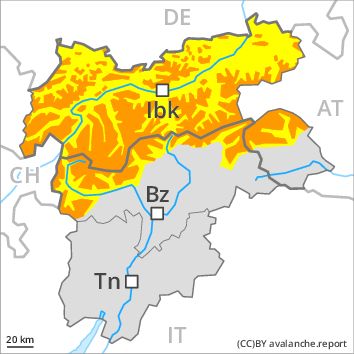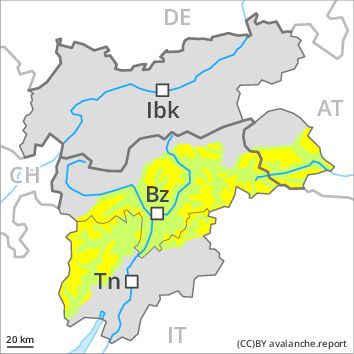Regions
Val Müstair Alps, Western Verwall Mountains, Langtaufers, Eastern Verwall Mountains, Schnals Ridge, Silvretta, Southern Stubai Alps, Samnaun Mountains, Southern Zillertal Alps and High Tauern, Northern Oetz and Stubai Alps, Saldurn-Mastaun Ridge, Western Tuxer Alps, Texel Mountains, Eastern Tuxer Alps, Western Kitzbühel Alps, Eastern Kitzbühel Alps, Glockturm Range, Durreck Range, Weißkugel Range, Western Rieserferner Mountains, Gurgler Range, Central Stubai Alps, Ortler Range, Northern Zillertal Alps, Allgäu Alps, Venediger Range, Eastern Lechtal Alps - Ammergau Alps, Mieming Mountains, Eastern Rieserferner Mountains, Karwendel Mountains, Glockner Range, Brandenberg Alps, Wilder Kaiser Mountains - Waidring Alps, Western Lechtal Alps, Central Lechtal Alps, Grieskogel Mountains

Danger level
Danger Level 3 - Considerable above the treeline
Danger Level 2 - Moderate above the treeline
Avalanche Problem
Wind-drifted snow above the treeline, N-NE-E-SE-S-SW-W-NW

The backcountry and freeriding conditions remain to some extent critical. Wind slabs represent the main danger.
As a consequence of fresh snow and a storm force to violent wind, extensive wind slabs formed in the last three days especially in gullies and bowls and behind abrupt changes in the terrain. Even single winter sport participants can release avalanches in many places, including dangerously large ones.
As a consequence of solar radiation individual natural loose snow slides are possible. This applies in particular on extremely steep sunny slopes.
Snowpack
dp 6: cold, loose snow and wind
dp 9: graupel blanketed with snow
The snowpack will be subject to considerable local variations. Since Tuesday extensive wind slabs formed in particular above the tree line. In some cases the various wind slabs have bonded still only poorly together. The old snowpack will be wet all the way through below approximately 2300 m.
Tendency
Gradual decrease in avalanche danger.
Regions
Sexten Dolomites, Eastern Pfunderer Mountains, Latemar, Western Deferegger Alps, Ulten Valley, Eastern Nonsberger Alps, Northern Dolomites of Fiemme, Gröden Dolomites, Southern Adamello, Eastern Deferegger Alps, Prags Dolomites, Sarntal Alps, Adamello - Presanella, Schober Mountains, Western Pfunderer Mountains, Northern Brenta - Peller, Lienzer Dolomites, Western Nonsberg Alps, Southern Brenta, Fassa Valley, Sole, Pejo and Rabbi, Maddalene

Danger level
Danger Level 2 - Moderate above the treeline
Danger Level 1 - Low above the treeline
Avalanche Problem
Wind-drifted snow above the treeline, N-NE-E-SE-S-SW-W-NW

Wind slabs require caution.
The mostly shallow wind slabs of the last three days can be released easily above the tree line. The avalanche prone locations are to be found in particular adjacent to ridgelines and in gullies and bowls in all aspects. They will increase with altitude. In the regions neighbouring those that are subject to danger level 3 (considerable) the avalanche danger is higher.
Snowpack
dp 6: cold, loose snow and wind
The sometimes storm force wind has transported the fresh and old snow significantly. In particular adjacent to ridgelines and in gullies and bowls brittle wind slabs formed. This applies in particular above the tree line.
Tendency
The danger of dry slab avalanches will decrease gradually.
Regions
Primiero - Pale di S. Martino, Prealps, Cembra Valley, Bondone and Stivo, Vallarsa, Folgaria - Laverone, Southern Lagorai, Ledro Valley, Northern Lagorai, Paganella, Marzola - Valsugana, Pine' - Mocheni Valley

Danger level
Danger Level 2 - Moderate above the treeline
Danger Level 1 - Low above the treeline
Avalanche Problem
Wind-drifted snow, N-NE-E-SE-S-SW-W-NW
Persistent weak layer above the treeline, N-NE-E-SE-NW

Wind slabs and weakly bonded old snow require caution.
More recent wind slabs are mostly rather small and can be released by large loads in particular. At high altitudes and in high Alpine regions avalanche prone locations are a little more prevalent. A clear night will be followed in the early morning by favourable conditions generally. In steep terrain there is a danger of falling on the icy crust.
Snowpack
dp 7: snow-poor zones in snow-rich surrounding
The snowpack will be in most cases well bonded. Adjacent to ridgelines and in gullies and bowls mostly small wind slabs formed. Avalanche prone weak layers exist in the old snowpack in particular on very steep grassy slopes.
Tendency
At transitions from a shallow to a deep snowpack and on wind-loaded slopes the avalanche situation is rather unfavourable.



